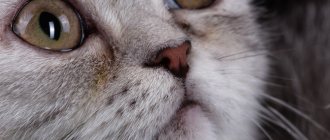And so, you decided to pet your cat. Your hand slides over the soft fur, and in response you hear a grateful purr. And everything would be fine, but this idyll has an unexpected ending. The cat suddenly releases its claws and digs its teeth right into your hand. And why would that be? Despite the absence of visible reasons, there is nothing surprising in this behavior. Let's figure out why cats change mercy for anger so quickly and how to stop a cat from biting when you pet it.
Why do cats behave this way?
Let's conduct an experiment. Start stroking your left knee with your right hand. Preferably in the same place. Now focus on your feelings. While not irritating at first, they will eventually become unpleasant and then painful. And eventually you will want to stop this strange activity.
Or remember yourself as a child. Mom reads a fairy tale and strokes your head. At first, the touches are pleasant, but after a few minutes you want to wriggle thoroughly so that your mother’s hand slides off the top of your head.
Your cat experiences approximately . At first, these touches are pleasant to him, but then he may stop liking them. Only the pet has no chance to communicate this with his voice, so he acts using his own methods: teeth and claws.
Animal psychologists call this process hyperstimulation and there is an opinion that it is what underlies such sudden aggression in cats in response to affection.
Top How to stop a cat from biting when you pet it?
Many owners ask themselves this question, but not everyone understands that the first thing to correct is their behavior. After all, it is precisely this that can provoke the mustachioed to use teeth, claws, and sometimes all together.
Up
Ways to solve the problem
By asking specialists why a cat bites for no reason, it is unlikely that you can get an explanation. The animal will not release its claws or teeth just like that. Any manifestation of aggression is caused by certain factors. Therefore, the most important rule is not to punish your pet for this. This behavior will only make the situation worse.
What should you do if you try to bite a cat? It is recommended to leave him alone for a while without trying to show affection. Communication with your pet cannot be combined with other activities. You need to give him your full attention. Then you can notice signs of growing discontent in time.
You can make a wild cat want to receive affection from its owner through training. If you give your cat a treat every time you interact, it will eventually associate stroking with something pleasant.
Pay attention to the signals
Perhaps the bite came as a surprise to you, but if you take a closer look, the cat was probably giving you signals that the caresses had become unpleasant to him. Take a closer look, maybe you will have time to notice some of them before it comes to a fight.
- The cat raised its muzzle and looks at the hand
- The cat flattened his ears
- The pupils suddenly dilated or constricted
- The cat beats his tail
- Backing away
- Tries to run away
- Meows
- He tries to bend under his hand so that it doesn’t touch him in any way.
Don't let things get to the point of bites! Observe the signals and stop stroking as soon as the mustache gives them. In this way, you will let him know that you are ready to stop unpleasant actions based on a signal from your tail, not your teeth. Over time, such training will teach the cat to give you correct and harmless signals , because he will know that they work.
Up Improve your technique
Petting cats is an art. This is not playing the drum, but rather playing the cello. Force and rudeness are not needed here, but improvisation is valued. To touch the delicate strings of a cat's sensitive soul, act gently, do not be nervous and do not scratch the cat in the same place for several minutes.
We often pet cats automatically when we are busy doing something. For example, we watch TV. At this moment, our hand makes the same movements along the same trajectory, which can irritate the pet. Pay attention to this!
Learn where the cat enjoys touching and where stroking is prohibited. As a rule, cats love to be stroked on their face, neck, back of the head, and allowed to stroke their back, but touching their belly and paws is a provocation. But remember: your cat may be the exception to the rule. Check it out!
Up
How to react to bites while stroking
The animal's further behavior is determined by the owner's reaction. If you have been bitten, use the following recommendations:
- Click the cat's nose. This action will help distract her from your hands. The most important thing is to correctly calculate the applied force. The click should be unpleasant, but not painful.
- Make a sharp sound. A whistle or clap can also switch attention and stop the furry aggressor.
- Release the stream from the spray bottle. A wet animal will immediately rush to lick its coat and leave you alone.
- Silently leave the room. Your departure will show that the wrong reaction is fraught with loss of attention. This method is effective only if the pet is not tired of being petted. It is also not suitable in the presence of pain, stress and fear.
Under no circumstances allow retaliatory aggression. Loud screams and physical assault will either irritate the cat even more or greatly frighten it. In both cases, the undesirable behavior will only become stronger, and with it, distrust in the person will appear.
Be aware of your body language. Be sure to stop stroking if the following signs occur:
- pressing the ears to the head or spreading them apart;
- slight twitching of the tail and back;
- hissing or displeased meowing;
- body tension.
Try to avoid intrusiveness and coercion. Don't pet your cat if he's nervous and trying to get away from you. Remember the sense of tact and the right to personal space. Your pet deserves them no less than you.
Pay more attention to games
Here’s another way to stop a cat from scratching when you pet it, although it will take time from you. At least an hour a day! The fact is that sometimes hyperstimulation in cats occurs due to boredom, and that is why they react to affection with aggression. To fix this, come up with an interesting activity . Here are some ideas:
- Games with a toy on a stick
- Interactive food puzzles
- Battery operated toys
- Games with rattling objects
- Ball games
Top Take your pet to the veterinarian
If your cat suddenly begins to show aggression in response to stroking, and previously did not have such a habit, you should pay attention to his health. Cats with a number of diseases may well react this way to the pain that your touch caused them. A trip to the veterinarian will not be a bad idea.
Up
Why are cat bites dangerous?
Research has shown that after cat bites, one in three people attacked requires hospitalization. Why is such an act so threatening that it could land the victim in the hospital? Not at all because of bacteria in saliva. Their teeth are to blame for much of the damage caused by these rodents.
Dog teeth are relatively blunt and wide, and do not penetrate so deeply into the tissue. Cat incisors are sharp, like saws, and easily drive to great depths, moving saliva bacteria, streptococci and staphylococci from human skin to the center of the wound.
As bacteria spreads in the wound, the pain becomes stronger and stronger, swelling may appear around the damaged area, and the infection spreads along with the blood. Therefore, act quickly:
- First, don't block the blood. Allow it to flow spontaneously from the wound for a while, clearing it of germs.
- Secondly, wash the bitten area with soap and water and disinfect it with hydrogen peroxide or antiseptics.
- Third, apply antibiotic ointment.
- Fourth, put on a bandage.
All this can and should be done immediately after the incident. Then it is best to contact your doctor directly. If you are unable to do this, monitor your condition for fever, swelling, or throbbing severe pain, not necessarily limited only to the wound site. If you notice alarming symptoms, be sure to visit the hospital.
There are many methods that can be used to eliminate bad habits in a cat. But before that, you need to find out why he bites. The reason may be in the owner himself, in his behavior. Negative factors must be completely eliminated for the animal’s behavior to return to normal. Then it will purr and not bite. If you do this at a young age, there should be no problems with the cat later.
Incorrect socialization: problems in education
Representatives of the cat family should be tamed from an early age. It’s even better if you are with the kittens from birth, taking responsibility for the growing animals. Why is this so important?
photo from website: iheartcats.com
- Experts say: babies who regularly had contact with a person before 7 weeks of age are more trusting and more willing to participate in games and go into the arms of their owner than strays who do not receive their share of care and love.
- Attention from the owner is the key to proper upbringing. By studying your cat's behavior day after day, you will learn to distinguish features that are invisible to others and prevent brewing “conflicts.”
However, such a theory does not explain why animals that have lived side by side with humans all their lives suddenly become completely uncontrollable.
How to determine readiness for attack
Usually a cat does not bite your hand suddenly. He is preparing to attack, and this can be recognized by the following signs:
- first the cat stops “singing songs”;
- the purr begins to move its tail intensively;
- gradually the pet’s whole body becomes tense;
- he begins to growl, hiss, and “talk” with displeasure;
- pupils dilate;
- The ears either press down or actively move.
By observing your pet's behavior based on the above signs, you will be able to detect that the animal is showing dissatisfaction. Just remove your hand and the conflict will be over.
Aggression through sleep
photo from website: student.cnnindonesia.com
If the cat falls asleep in your arms, try not to make sudden movements. Otherwise, the pet will not understand what happened and may bite you painfully, frightened by your touch and instinctively protecting itself.
Also, such behavior of a pet can be explained by an attempt to control the situation - this is how your pet is trying to tell you: “I decide when I can be petted and when not.” At the same time, the position he occupies is dominant. That is why it is important to accustom your cat to a different state of affairs, because you should be the master of the house, not a capricious animal.
Pathological conditions
The exact reasons why a cat bites can only be determined by carefully observing your pet. Apathy, lethargy, bowel movements, permanent lack of appetite, combined with aggressive behavior, may be symptoms of a serious illness that requires immediate attention to a veterinary clinic.
If the cat has never bitten before and behaved peacefully, then a sudden change in behavior may indicate the development of certain pathologies, for example:
- infectious and inflammatory processes;
- periodontitis;
- cervical arthritis;
- renal pathologies.
Traumatic injuries, sometimes invisible to the naked eye, also cause severe pain to the animal, especially when touched.
Aggression for no reason: why do we get it?
There were no signs: you were playing peacefully with the animal or just sitting next to it, running your palm over the pet’s fur. All that happened after was a sudden attack, bites and scratches. The owner was shocked, and the “wild beast” fled the crime scene. How to recognize a threat and prevent a fight, and most importantly, understand why you became a victim?
photo from the site: www.medicaldaily.com
Experienced owners know that nothing happens “just like that,” and there is a reason for your cat’s bad behavior. True, it is very difficult to fully understand what causes outbursts of uncontrollable aggression in animals. There are several theories that explain the hostility that pets so violently display towards their owner. And here are just a few of them.
Manifestation of instinct
If an animal makes a “bite”, this indicates the manifestation of instinct. It can be hunting or protective. As you know, cats tend to catch small prey: birds or mice. The cubs capture prey with their fangs. If there is no opportunity to hunt, cats begin to bite furniture, toys or the owner’s hands. The exception is the Ragamuffin breed, which has no hunting instinct at all.
The protective instinct manifests itself not only in attack, but also in defense. Cats use it when they feel fear, pain, anger or love. In the latter case, cats bite their fingers a little without damaging the skin. They don't even show their claws. Considering that the person does not experience pain, this speaks of the trust and devotion of the pet.











